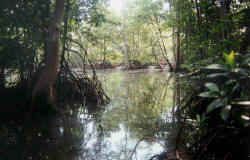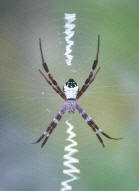Introduction
| |
|
|
 |
| |
Mangrove
system at low tide - this area is dominated by the aerial roots of
Rhizophora sp. |
| |
|
Prior to the settlement of Singapore the land around
the inlet of Sungei Buloh, in the northwest of the main island of
Singapore, was dominated by tidal mudflats and mangrove systems. It is
possible that bamboo once existed in the area, hence the name (Sungei =
River, Buloh = Bamboo), however the bamboo is long gone. In the 19th
Century, with an increasing rural population, prawn farming became the
mainstay of those settling the coast. Now the prawn farms are gone and the
mangroves are regenerating under the protection afforded by the Nature
Reserve. Opened in 1993, this 87 hectare wetland refuge is of supreme
importance during the migration of waders and shorebirds between the
summer breeding grounds of North Asia (Siberia, China etc.) and the
wintering grounds of the Southern Hemisphere (Australia etc.). This
migration route is the East-Asian Flyway.
The migratory birds are attracted by exposed mud
flats in the long-abandoned prawn ponds. Water levels in the prawn ponds
are still controlled by sluice gates; the aim is to maintain some exposed
mud flats at all times, even during high tide, thereby attracting waders
and shorebirds. In addition to tidal systems there are a small number of
freshwater ponds and patches of secondary forest which add to the
reserve's biodiversity.
Visitor Facilities
Run by the National Parks Board (NParks), Sungei
Buloh boasts an excellent visitor centre complete with educational
displays, theatrette, knowledgeable staff, a cafeteria and public toilets.
Viewing hides are dotted at strategic locations, and the trails are well
maintained and clearly marked. Boardwalks, currently under renovation,
allow visitors to explore deep into the mangroves.
What to expect
| |
 |
| |
Flocks of shorebirds migrate
through the reserve from September to March |
| |
|
Sungei Buloh Wetland Reserve allows easy viewing of
the elements which comprise a Mangrove Ecosystem. Compare the root systems
of Avicennia, Bruguiera and Rhizophora mangrove species, each of which
has evolved different morphology to allow growth in an anoxic, muddy
environment. The littoral zone (i.e. the region between low and high water
marks) is dominated by crabs and mudskippers; keep an eye open for
occasional fights between the territorial male mudskippers. Above the
normal high tide level are mud lobsters; look for their volcano-like
mounds. In these margins you will encounter the
Malayan Water Monitor;
these, large fearsome looking lizards have recently become quite numerous,
probably as they are no longer hunted. Adults of up to 6 feet can be seen.
The cessation of fishing in the area has allowed the
recovery of abundant fish life. Easily seen from the main bridge across
the Sungei Buloh inlet are shoals of Mullet, Halfbeak, Green Chromite and
Archer Fish. The latter will attempt to shoot down unwary insects who
stray too close with a well-aimed burst of water.
 |
|
|
Purple Herons Ardea purpurea
nesting at
The Heronry |
|
| |
|
During the migration season, from September to
March, the mudflats near the Main Hide are alive with thousands of wading
birds feeding on the rich fauna of bivalves, crabs, worms and molluscs.
Species to expect include Whimbrel, Common Greenshank, Common Redshank,
Mongolian Plover, Curlew Sandpiper, Marsh Sandpiper and Pacific Golden
Plover. In the margins the Yellow Bittern, Cinnamon Bittern and Striated
(Little) Heron may be seen preying on small fishes.
During the summer breeding season, from April to
August, one's attention is not only drawn towards the resident Little
Egret and Great Egret, who prefer to keep their distance, but also to the
mixed breeding colony of Purple Heron and Grey Heron. The Heronry
comprises hundreds of nests, some under construction, others struggling to
contain noisy, hungry fledglings with indignant expressions. The constant
arrival and departure of the adult birds makes the skies as busy as Changi
Airport !
| |
 |
| |
A flock of Little Egrets
Egretta garzetta takes flight |
| |
|
At all times of the year passerine bird species can
be seen, including the Collared Kingfisher and Stork-billed Kingfisher
patrolling the mangroves. Dollarbirds occur high up in the treetops
swooping down on larger insects, and the locally common, but likeable,
Yellow-vented Bulbul is always seen bubbling amongst the flowering trees.
In total, over 170 species of bird have been identified in the reserve.
Many mangrove species are shy. Wildlife observation
at Sungei Buloh, as elsewhere, requires patience, a careful eye and a
quiet demeanour. Slow down and you may well be rewarded with a special
encounter.
| |
|
 |
|
|
This resident family of Smooth
Otters Lutrogale perspicillata have an easy life in Sungei Buloh |
|
| |
|
If You're Lucky ...
Otters occur within Sungei Buloh Wetland Reserve; a
family of four Smooth Otters has recently been seen, and the addition of
cubs suggests they are breeding locally. Hopefully the now abundant fish
life will encourage an expansion of the otter population. Should you see
any otters report their location in the Observations Book kept at the
reserve entrance. For further details on the Smooth Otters see the article
"Ring Of Bright Water".
During the annual bird migration rarer species may
be seen including the Asian Dowitcher and the endangered Chinese Egret.
Ducks and geese are not common, however the locally uncommon Lesser
Whistling-duck (Lesser Treeduck) may sometimes be seen in the freshwater
ponds.
Which Trail to Take ?
| |
 |
| |
St. Andrew's Cross spiders
weave their webs high in the mangroves |
| |
|
There are three well-defined routes :
Route-1 encircles the two main ponds where, between
September and March, migratory waders tend to congregate. The route also
gives a good view across the Johor Straits to the Malaysian border town of
Johor Bahru. Allow at least two hours to complete this three kilometre
circuit.
Route-2 leads off Route-1 and passes the Heronry.
When re-opened the Main Boardwalk will allow visitors to complete a
circular route back to Route-1. Allow four hours to complete the five
kilometres of both Route-1 and Route-2.
Route-3 leads from Route-2 to the freshwater ponds,
adding an extra 1.5 kilometres before returning to Route-2. This quiet,
peaceful corner of the reserve my reward visitors with sightings of the
hanging nests of the Baya Weaver and other shy species. Allow at least 5
hours to complete the total 6.5 kilometres of trails.
Volunteer Program
Under the auspices of the National Parks Board a
volunteer program operates in Sungei Buloh Wetland Reserve. Volunteers
provide free guiding at the weekends, assist in species surveys, and help
promote the activities of the reserve to the public.
|